-
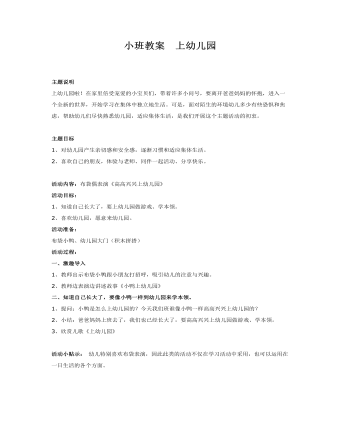
小班教案 上幼儿园课件教案
主题目标1、对幼儿园产生亲切感和安全感,逐渐习惯和适应集体生活。2、喜欢自己的朋友,体验与老师、同伴一起活动、分享快乐。活动内容:布袋偶表演《高高兴兴上幼儿园》活动目标:1、知道自己长大了,要上幼儿园做游戏、学本领。2、喜欢幼儿园,愿意来幼儿园。活动准备:布袋小鸭、幼儿园大门(积木拼搭)
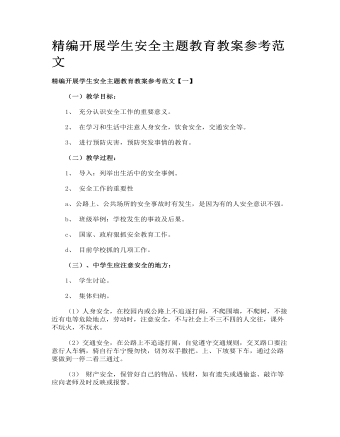
精编开展学生安全主题教育教案参考范文
交通安全 1. 行走时怎样注意交通安全 1)在道路上行走,要走人行道,没有人行道的道路,要靠路边行走。 2)集体外出时,要有组织、有秩序地列队行走。 3)在没有交通民警指挥的路段,要学会避让机动车辆,不与机动车辆争道抢行。 4)穿越马路时,要遵守交通规则,做到“绿灯行,红灯停”。 2. 交通安全 :全国平均每天发生交通事故 1600 起, 死亡 257 人 , 受伤 1147 人 , 直接经济损失 731 万。真是令人痛心。提醒学生们要特别注意交通安全,上放学时一定要遵守交通规则,过马路时要提高警惕,注意来往的车辆。及时消除交通隐患。
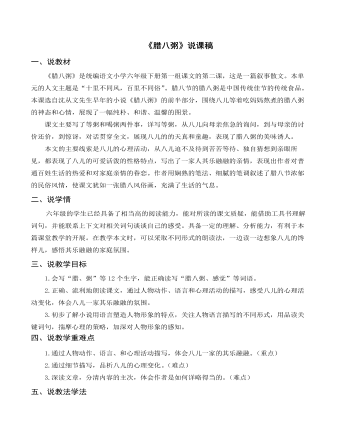
部编人教版六年级下册《腊八粥》说课稿
一、说教材《腊八粥》是统编语文小学六年级下册第一组课文的第二课,这是一篇叙事散文。本单元的人文主题是“十里不同风,百里不同俗”。腊八节的腊八粥是中国传统佳节的传统食品。本课选自沈从文先生早年的小说《腊八粥》的前半部分,围绕八儿等着吃妈妈熬煮的腊八粥的神态和心情,展现了一幅纯朴、和谐、温馨的图景。课文主要写了等粥和喝粥两件事,详写等粥,从八儿向母亲焦急的询问,到与母亲的讨价还价,到惊讶,对话贯穿全文,展现八儿的的天真和童趣,表现了腊八粥的美味诱人。 本文的主要线索是八儿的心理活动,从八儿迫不及待到苦苦等待、独自猜想到亲眼所见,都表现了八儿的可爱活泼的性格特点,写出了一家人其乐融融的亲情,表现出作者对普通百姓生活的热爱和对家庭亲情的眷恋。作者用娴熟的笔法、细腻的笔调叙述了腊八节浓郁的民俗风情,使课文犹如一张腊八风俗画,充满了生活的气息。
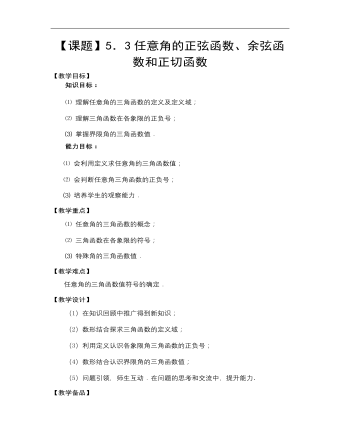
【高教版】中职数学基础模块上册:5.3任意角的正弦函数、余弦函数和正切函数
【教学目标】知识目标:⑴ 理解任意角的三角函数的定义及定义域;⑵ 理解三角函数在各象限的正负号;⑶掌握界限角的三角函数值.能力目标:⑴会利用定义求任意角的三角函数值;⑵会判断任意角三角函数的正负号;⑶培养学生的观察能力.【教学重点】⑴ 任意角的三角函数的概念;⑵ 三角函数在各象限的符号;⑶特殊角的三角函数值.【教学难点】任意角的三角函数值符号的确定.【教学设计】(1)在知识回顾中推广得到新知识;(2)数形结合探求三角函数的定义域;(3)利用定义认识各象限角三角函数的正负号;(4)数形结合认识界限角的三角函数值;(5)问题引领,师生互动.在问题的思考和交流中,提升能力.
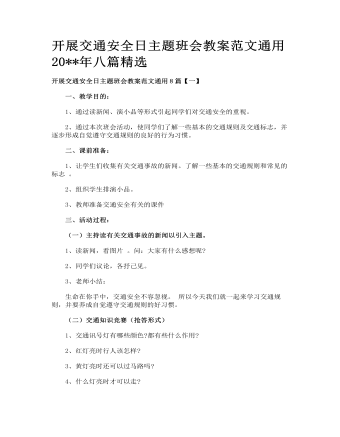
开展交通安全日主题班会教案范文通用八篇精选
骑自行车的交通安全 我国是自行车大国,许多年满12周岁的同学都骑自行车上学,骑自行车应注意哪些问题呢?下面请听一名同学朗诵《安全骑车歌》。 安全骑车歌 同学们骑自行车,听我唱段安全歌。 车铃好使闸要灵,有了情况车能停。 上街注意看信号,千万不要冒险行。 信号就是指挥员,骑车第一讲安全。 看见红灯快刹闸,该等多久等多久。 绿灯亮了才能行,安全通行不争抢。 十字路口人车多,左右观察听八方。 骑车带人危险大,攀扶车辆更可怕。 中速骑车靠右侧,分道行驶路畅通。 骑车拐弯要示意,不能猛拐一溜风。 手拉手儿把肩摸,十有八、九要撞车。 双手离把更不行,撞上汽车命归西。 骑车不走一条线,东摇西摆像醉汉。 不定哪天出事故,头破血流住医院。 驮载东西别超宽,超高超长也危险。 骑车让让讲安全,事情虽小不平凡。
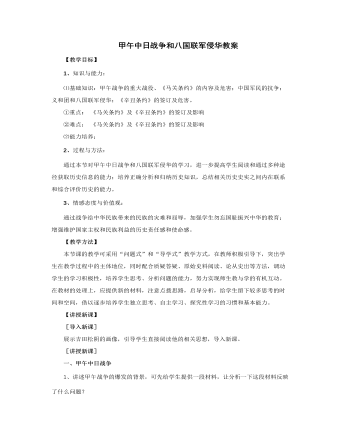
人教版高中历史必修1甲午中日战争和八国联军侵华教案
(1)巨额的赔款,是列强对中国空前的大规模勒索;为支付这笔巨额赔款,清政府加紧搜刮人民,使人民生活更加贫困,社会经济更加凋敝。(2)在北京设立的“使馆界”,实际上是“国中之国”,是帝国主义策划侵略中国的大本营。外国侵略者控制京津地区,使清政府完全处于外国军队的控制之下,便于侵略者直接派兵镇压中国人民的反帝斗争。(3)按照条约规定,清朝官吏严厉镇压中国人民的反帝斗争,进一步成为帝国主义的帮凶。(4)改设外务部的规定,便于清政府能够按照外国侵略者的意旨实行卖国的外交政策。《辛丑条约》是帝国主义强加给中国的一个严重的不平等条约,列强除了穷凶极恶地对中国敲诈勒索外,还重新确立了以慈禧太后为首的清政府继续充当它们在华的代理人。
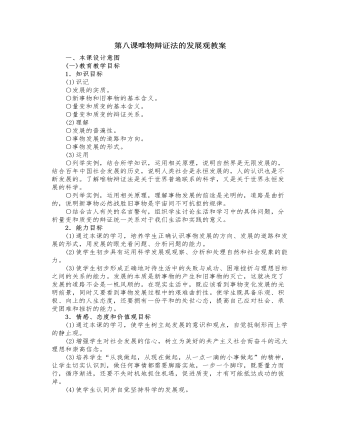
人教版高中政治必修4第八课唯物辩证法的发展观教案
1973年4月的一天,一名男子站在纽约的街头,掏出一个约有两块砖头大的无线电话,并开始通话。这个人就是手机的发明者马丁,当时他是摩托罗拉公司的工程技术人员。这是当时世界上第一部移动电话。1985年,第一台现代意义上的可以商用的移动电话诞生。它是将电源和天线放置在一个盒子里,重量达3公斤。与现代形状接近的手机诞生于1987年,其重量大约750克,与今天仅重60克的手机相比,像一块大砖头。此后,手机的“瘦身”越来越迅速。1991年,手机重量为250克左右。1996年秋,r出现了体积为100立方厘米、重量100克的手机。此后,又进一步小型化,轻型化,到1999年就轻到了60克以下。手机的体积越来越小,但功能却越来越多。以前的手机是用来通话的,现在的手机是用来享受的。今天,手机可以是相机、游戏机、音乐播放器、信用卡、电影院……手机带来的不仅仅是通信方式的改变,更是生活方式的变革。
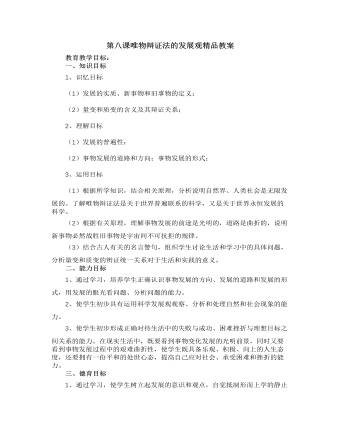
人教版高中政治必修4第八课唯物辩证法的发展观精品教案
2、理解目标(1)发展的普遍性;(2)事物发展的道路和方向;事物发展的形式;3、运用目标(1)根据所学知识,结合相关原理,分析说明自然界、人类社会是无限发展的。了解唯物辩证法是关于世界普遍联系的科学,又是关于世界永恒发展的科学。(2)根据有关原理,理解事物发展的前途是光明的,道路是曲折的,说明新事物必然战胜旧事物是宇宙间不可抗拒的规律。(3)结合古人有关的名言警句,组织学生讨论生活和学习中的具体问题,分析量变和质变的辨证统一关系对于生活和实践的意义。二、能力目标1、通过学习,培养学生正确认识事物发展的方向、发展的道路和发展的形式,用发展的眼光看问题、分析问题的能力。2、使学生初步具有运用科学发展观观察、分析和处理自然和社会现象的能力。3、使学生初步形成正确对待生活中的失败与成功、困难挫折与理想目标之间关系的能力。
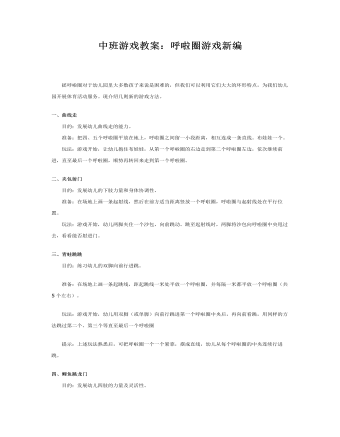
中班游戏教案:呼啦圈游戏新编
一、曲线走 目的:发展幼儿曲线走的能力。 准备:把四、五个呼啦圈平放在地上,呼啦圈之间留一小段距离,相互连成一条直线。布娃娃一个。 玩法:游戏开始,让幼儿抱住布娃娃,从第一个呼啦圈的右边走到第二个呼啦圈左边,依次继续前进,直至最后一个呼啦圈,顺势再转回来走到第一个呼啦圈。二、夹包射门 目的:发展幼儿的下肢力量和身体协调性。 准备:在场地上画一条起射线,然后在前方适当距离竖放一个呼啦圈,呼啦圈与起射线处在平行位置。 玩法:游戏开始,幼儿两脚夹住一个沙包,向前跳动。跳至起射线时,两脚将沙包向呼啦圈中央甩过去,看看能否射进门。
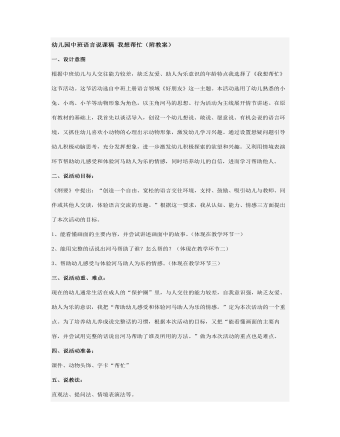
幼儿园中班语言说课稿:我想帮忙(附教案)
本次活动我设计以下三个环节:一、展示《我想帮忙》课件,引导幼儿看图说话,并认读词语:帮忙。二、引导幼儿情境讲述,进一步理解画面内容。三、尝试表演,感受和体验河马助人为乐的情感。一、展示《我想帮忙》课件,引导幼儿看图说话,并认读词语:帮忙。1、谈话导入:(教师神秘地说)告诉大家一个秘密:老师发现了一群小动物们之间的故事,你们想知道吗?可是,小动物们说了要想知道它们的秘密必须靠小朋友自己,要用自己的小眼睛认真观察,动脑筋思考,还要大胆回答出问题才行呢!大家能做到吗?就让我们一起来试试吧!(出示幻灯一)引导幼儿说说画面中的小动物们都在干什么。(出示幻灯二)猜猜“河马会怎么帮忙呢?”(这样的设计就是抓住幼儿喜欢小动物的心理,利用幼儿观察小动物们生活化的动作形态和解答悬疑问题,激发幼儿的学习兴趣。)2、(出示幻灯三——六)在展示画面的过程中,引导幼儿认真观察,鼓励幼儿大胆、清楚地表达自己的想法和感受,发展幼儿的语言表达能力和思维能力,并使幼儿养成注意倾听的好习惯。3、认读词语:帮忙。利用字卡和情境画面帮助幼儿直观形象地去了解、认识词语,再通过游戏《帮字宝宝找朋友》进一步加深理解词语。
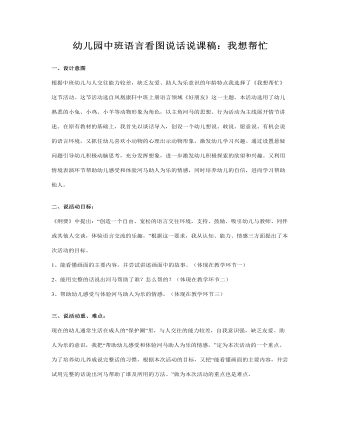
幼儿园中班语言说课稿:我想帮忙(附教案)
二、说活动目标:《纲要》中提出:“创造一个自由、宽松的语言交往环境,支持、鼓励、吸引幼儿与教师、同伴或其他人交谈,体验语言交流的乐趣。”根据这一要求,我从认知、能力、情感三方面提出了本次活动的目标。1、能看懂画面的主要内容,并尝试讲述画面中的故事。(体现在教学环节一)2、能用完整的话说出河马帮助了谁?怎么帮的?(体现在教学环节二)3、帮助幼儿感受与体验河马助人为乐的情感。(体现在教学环节三)三、说活动重、难点:现在的幼儿通常生活在成人的“保护圈”里,与人交往的能力较差,自我意识强,缺乏友爱、助人为乐的意识,我把“帮助幼儿感受和体验河马助人为乐的情感。”定为本次活动的一个重点。为了培养幼儿养成说完整话的习惯,根据本次活动的目标,又把“能看懂画面的主要内容,并尝试用完整的话说出河马帮助了谁及所用的方法。”做为本次活动的重点也是难点。

初中语文常考常见的别词、别字教案教学设计
1、三年的汗水,终于有了回报。站在领奖台上,她兴奋得不能自己,泪水刷刷地流了下来。误:不能自己 正:不能自已[bù néng zì yǐ] 2、灯光下面,人头攒动。这条街上陈列的,其实大都是膺品,但还是热闹非凡。误:膺品 正:赝品[yàn pǐn]3、待学生从农村基地回来时,校舍已修茸一新,三幢大楼披上了节日的盛装。误:修茸 正:修葺[xiū qì] 4、埋伏在左侧的三连,听到冲锋号响,尤如猛虎下山,直扑敌人阵地。误:尤如猛虎下山 正:犹如猛虎下山[yóu rú] 5、粗制滥造,哄抬市价,这种竭泽而鱼的做法,最后必然会让自己受到惩罚。误:竭泽而鱼 正:竭泽而渔[jié zé ér yú] 6、自从钢琴热掀起后,钢琴教师身价倍增,一批“三脚猫”也混迹其中,滥芋充数。误:滥芋充数 正:滥竽充数[làn yú chōng shù] 7、阳光穿射而入,配着店堂排列得整整齐齐的书架,真是一个书香花香阳光普照的世外桃园。误:世外桃园 正:世外桃源[shì wài táo yuán]8、在调查过程中,陈又将大批赃款转移至岳父处,专案组找他谈话时,他依旧装得若无其事。误:脏款 正:赃款[zāng kuǎn]
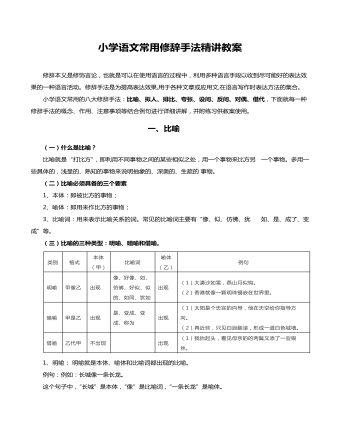
小学语文修辞手法教案专题课件
1、明喻: 明喻就是本体、喻体和比喻词都出现的比喻。例句:例如:长城像一条长龙。这个句子中,“长城”是本体,“像”是比喻词,“一条长龙”是喻体。2、暗喻: 暗喻又叫隐喻,只出现本体和喻体,不用比喻词语或用“是、变成、成为、等于”等喻词。例句:例如:山间的云雾构成了一幅精妙的山水画。这个句子中“山间的云雾”是本体,“构成”是比喻词,“一幅精妙的山水画”是喻体。3、借喻: 借喻是只出现用来代替本体的喻体,而本体和喻词都不出现。例句:落光了叶子的柳树上挂满了毛茸茸、亮晶晶的银条儿。这个句子中,本体、比喻词均没有出现,喻体是“银条儿”。
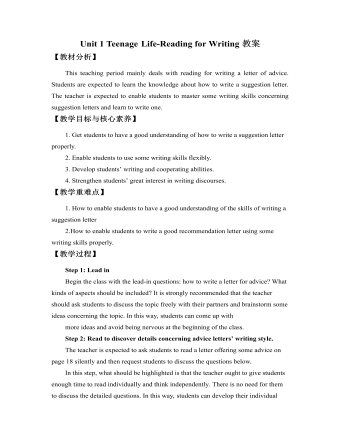
新人教版高中英语必修1Unit 1 Teenage Life-Reading for Writing教案
【教材分析】This teaching period mainly deals with reading for writing a letter of advice. Students are expected to learn the knowledge about how to write a suggestion letter. The teacher is expected to enable students to master some writing skills concerning suggestion letters and learn to write one.【教学目标与核心素养】1. Get students to have a good understanding of how to write a suggestion letter properly.2. Enable students to use some writing skills flexibly.3. Develop students’ writing and cooperating abilities.4. Strengthen students’ great interest in writing discourses.【教学重难点】1. How to enable students to have a good understanding of the skills of writing a suggestion letter2.How to enable students to write a good recommendation letter using some writing skills properly.【教学过程】Step 1: Lead in Begin the class with the lead-in questions: how to write a letter for advice? What kinds of aspects should be included? It is strongly recommended that the teacher should ask students to discuss the topic freely with their partners and brainstorm some ideas concerning the topic. In this way, students can come up with more ideas and avoid being nervous at the beginning of the class.Step 2: Read to discover details concerning advice letters’ writing style.The teacher is expected to ask students to read a letter offering some advice on page 18 silently and then request students to discuss the questions below.

新人教版高中英语必修1Unit 2 Travelling Around-Reading for Writing教案
Is there a clear purpose for the trip? :Does each paragraph have a clear main idea? Does the writer use the present continuous tense for future plans?Does the writer use commas, stops, and question marks correctly? Are all the words spelt correctly?Are all the proper nouns capitalized?Revise your draft according to your partner's comments.Step 5:The summary of how to write a travel plan.旅游计划是一种常见的应用文写作。旅游可分为观光游、文化游、美食游及探险游等不同类型,因此旅游计划也要根据不同的旅游目的进行设计。常规的旅游计划需要明确以下几个方面的问题:Travel planWhen will you leave for? Where is your the destination?How will you get there?What will you do there?How long will you there?Is there a clear purpose for the trip? 为了提升旅行计划的层级,还需注意以下几个方面的问题:1.每段是否有明确清晰的主题;2.用一般现在时代替一般将来时;3.用更高级的形容词词汇。例如:表达“好”时,不要总用“nice”,我们还可以用“smart, clean, excellent, exciting, beautiful, wonderful, clever, famous, grand”等表达更具有指向性的词汇;4.用更高级的动词词汇。比如:我们可以用“seem stand, lie .get stay, remain, look . sound, become . keep, grow”等代替"be";

新人教版高中英语必修1Unit 4 Natural Disasters-Listening and Speaking教案
【教材分析】高考听力材料的选用非常重视语言真实性和交际性的原则,语言材料一般来源于实际生活,对话的内容大都取材于日常生活,即衣、食、住、行、工作、学习、天气、生活环境等话题,可分为校园、公共场所、家庭等方面,如: shopping, finding the way, doing one’s homework, seeing a doctor, making a phone call, weather report, asking for different kinds of information等。新教材的特点就是利用生活中真实文本,只是降低难度,让学生注重语言的应用,将是我们高考把握方向的重要因素。【教学目标与核心素养】学习能力目标:在听力当中,学生应该有效规划学习方法,选择恰当的策略与方法。这节课的训练目标是让学生有正确的预测和抓住问题的关键信息,从而用心去听来找寻关键信息。根据生活中实际情况和高考常见语境,我们不难发现提前预测和抓住题干中的w很重要,即what, where, when, why等等。
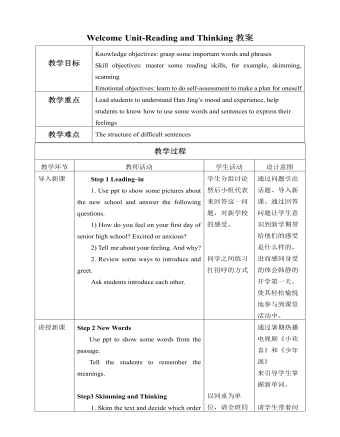
新人教版高中英语必修1Welcome Unit-Reading and Thinking教案
Step 2 New WordsUse ppt to show some words from the passage.Tell the students to remember the meanings.Step3 Skimming and Thinking1. Skim the text and decide which order Han Jing follows to talk about her first day. Time order or place order?Time order2. What is Han Jing worried about before she goes to senior high school?She is worried about whether she will make new friends and if no one talks to her, what she should do.Step 4 Fast Reading1. Match the main ideas with each paragraphParagraph 1:The worries about the new school day Paragraph 2Han Jing’s first maths classParagraph 3Han Jing’s first chemistry classParagraph 4Han Jing’s feelings about her first senior school dayStep 5 Careful Reading1. Fill in the chart with the words and phrases about Han Jing’s day. Answers: Senior high school, a little nervous; Her first maths class, classmates and teachers, friendly and helpful; Chemistry lab; new; great; annoying guy; Confident; a lot to explore2. Read the text again and discuss the questions.1) Why did Han Jing feel anxious before school?Because she was a new senior high student and she was not outgoing. What was more, she was worried about whether she can make friends.2) How was her first maths class?It was difficult but the teacher was kind and friendly. 3) What happened in the chemistry class? What would you do if this happened to you? A guy next to Han Jing tried to talk with her and she couldn’t concentrate on the experiment.

新人教版高中英语必修2Unit 1 Cultural Heritage-Reading and Thinking教案二
1. This section focuses on "Understanding how a problem was solved”, which is aimed to guide students to analyze and discuss the challenges and problems faced by cultural heritage protection during the construction of Aswan Dam, as well as the solutions. On the basis of understanding, students should pay attention to the key role of international cooperation in solving problems, and attach importance to the balance and coordination between cultural heritage protection and social and economic development. Students are encouraged to face challenges actively, be good at cooperation, and make continuous efforts to find reasonable ways and means to solve problems.2. Enable students to understand the main information and text structure of the reading text;3. Motivate students to use the reading strategy "make a timeline" according to the appropriate text genre;4. Enable students to understand how a problem was solved;5. Enable students to understand the value of protecting cultural heritage by teamwork and global community;1. Guide students to pay attention to reading strategies, such as prediction, self-questioning and scanning.2. Help students sort out the topic language about protecting cultural relics and understand the narrative characteristics of "time-event" in illustrative style3. Lead students to understand the value of protecting cultural heritage by teamwork and global community;

新人教版高中英语必修2Unit 2 Wildlife Protection-Listening &Speaking&Talking教案
Listening and Speaking introduces the topic of “how to save endangered wildlife and help wildlife in their neighborhood.” Due to the continuous deterioration of the living environment, a large number of wild animals are always facing the threat of endangered or extinction. Listening and speaking period enables students to understand the fact and reason why wild species are disappearing from the earth at an amazing speed, and realize that human beings ought to enhance the awareness of protecting wild species as soon as possible.Listening and Talking introduces the theme of " how to help wildlife in Ss’ neighborhood.". Now there are many volunteers who spontaneously protect wild animals, carry out various activities according to local conditions, and contribute their own strength to local animal protection with practical actions. Middle school students are also enthusiastic participants. They organize activities in their spare time, and take this opportunity to make friends, broaden their horizons, cultivate team spirit and communication skills. This section describes a bird watching activity organized by several middle school students of Bird watching Club. It aims to stimulate students' interest, improve their understanding of bird watching activities, and use the language structure of “being used for; in order to, so as to, to, so that, in order that ” to express the purpose for communication and discussion.1. Guide students to understand the content of listening texts in terms of using visuals to predict content.2. Cultivate students' ability to guess the meaning of words in listening; discuss with their peers how to save endangered wildlife and help wildlife in their neighborhood.3. Instruct students to use functional sentences of the dialogue such as “I am concerned about…” “what do you know about the endangered animals in…" and so on to talk about one of the endangered animals.

新人教版高中英语必修2Unit 3 The Internet-Listening &Speaking&Talking教案二
From the pictures in the text and the title--- choose the best app, we can know that this part is about how to save money by using apps.Step 2 While-listening1. Laura and Xiao Bo are talking about apps. Listen to their conversation and find out what apps they want.Xiao Bo is looking for a(n) exercise app to help him get in shape.Laura would like an app for getting rich and another that will make her grades better.2. Listen again. Are the sentences true T or false F?1). Both of Xiao Bo's apps keep track of the steps he takes._____2). Xiao Bo's second app can help him make a fitness plan._____3). Laura needs an app that will help her get discounts.______4). Laura needs an app that will add money to her bank account._______F T F T3. Listen once more and tick the sentence you hear. Underline the words used to express predictions, guesses, and beliefs.Predictions, Guesses, and Beliefs________It might help me walk more.________My guess is that it wouldn't work.________I imagine this app would help me get fit faster________I suppose that would be good.________I guess you could save a little with this app.________I suppose there would be some problems, too.________I believe this app could help me get thinner.